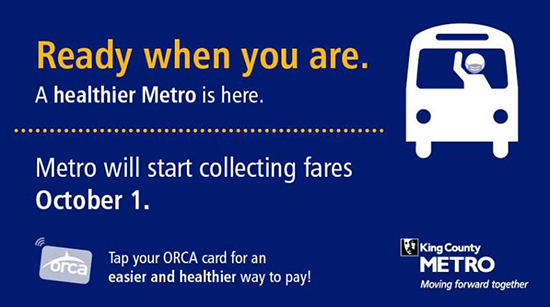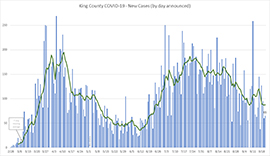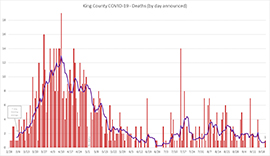
Dear Friends:
Todays update includes information on King County Metros fare collection resumption, a reminder to complete the 2020 Census, health updates, and more.
Washington Trivia
When was the incorporation of Des Moines?
(Answer is at the bottom).

King County Metro to resume fare collection Oct. 1
Beginning Thursday, October 1st, King County Metro will resume fare collection for all transit services: buses, Access paratransit, Seattle Streetcar (First Hill and South Lake Union), Vanpool, Via to Transit and other flexible services, and water taxi (Vashon Island and West Seattle).
While Metro continues to accept cash and paper tickets, as well as provide paper transfers, riders are encouraged to use a contactless payment option ORCA card or Transit GO Tickets to speed up the boarding process, and further protect both themselves and the operator.
Acquire an ORCA card online or in-person
Acquire Transit GO Tickets through your mobile device.
Pass Sales Office recently reopened to assist customers in getting ORCA cards and reloading their e-purses.
ORCA LIFT is available to help reduce the cost of riding Metro for those who qualify.
Youth and seniors are also eligible for reduced fares. To learn more and for help enrolling, call Metro at 206-553-3000 or visit www.kingcounty.gov/metro/fares.
Metro will suspend fare enforcement through the end of 2020. Fare enforcement officers will continue to provide a broad range of customer services, including answering questions related to using transit and navigating new safety innovations. Read more about it here.

2020 Census: Time is Running Out!
Time is running out to take the 2020 census and make an impact for the next 10 years. Complete the census by September 30th and count for the next 10 years. If our community is undercounted, we will not have a fair and full voice in policy and decision-making. Please do your part to make sure we are counted and represented. Visit 2020Census.gov to complete the census or call 844-330-2020.

Weekly King County Health Update: Vaping and COVID-19 in young people
The latest data shows young adults aged 20-39 represent 40% of COVID-19 cases in Washington state - the highest of any age group. While young adults and teens often have less severe coronavirus symptoms and illness, another kind of epidemic may alter this situation - the alarming increase in vaping by young adults and teens in King County. In 2018, nearly 8% of eighth graders, 17% of tenth graders, and 25% of twelfth graders reported vaping with nicotine as their most common choice.
While often touted as a safer form of smoking, Public Health Seattle - King County and the Washington Department of Health want young people to know that vaping greatly increases their risk of serious health issues. This is what we know about vaping nicotine and/or other substances:
Nicotine can negatively affect brain development in young people up to age 25, contributing to emotion or impulse control issues and anxiety. It can also contribute to or worsen cardiovascular disease and harm fetal development.
Nicotine can be highly addictive and toxic in high doses e-cigarette contents are unregulated, so nicotine concentrations are often unknown.
Nicotine and other substances can cause serious lung injury.

A recent study published online in the Journal of Adolescent Health links vaping with a significantly greater risk of COVID-19 in adolescents and young adults. Stanford School of Medicine researchers collected data from 4,351 online surveys completed by young people aged 13-24 years old from all 50 states, the District of Columbia, and three U.S. territories. This study revealed two major facts:
Participants who had used e-cigarettes anytime in their past were five times more likely to be diagnosed with COVID-19 than non-users.
Participants who had used both e-cigarettes and conventional cigarettes in the previous 30 days were 6.8 times more likely to be diagnosed with COVID-19.
You do not have to face this alone. If you or someone you know needs information or help with quitting vaping, please visit this website for some resources.
The Warning Signs for Suicide
September is known as Suicide Prevention Month and with the challenges that most of us are experiencing, it is important to review some of the warning signs for suicide. All warning signs require attention, and some require immediate action. However, warning signs of suicide should always be taken seriously, even if the person seems to be joking. Read more about it here.
Some warning signs can include:
Persistent or worsening trouble sleeping or eating
Feeling anxious or agitated
Increasing alcohol or drug misuse
Engaging in risky activities without considering the consequences
Withdrawing from family members and friends
Feeling rage or anger
Feeling hopeless, trapped, or like theres no way out
Feeling like there is no reason to live
The following can be signs of a suicidal crisis:
Making a plan for how or when to attempt suicide
Frequently talking, writing, or drawing about death or about items that can cause physical harm
Acting recklessly or engaging in risky activities without thinking about the consequences
Behaving violently, such as punching holes in walls, getting into fights, or engaging in acts of self-harm
Feeling rage or uncontrolled anger or seeking revenge
Taking risks that could lead to death, such as driving fast or running red lights
Giving away prized possessions
Putting your affairs in order, tying up loose ends, and/or making a will
Seeking access to firearms, pills, or other means of harming yourself
If you recognize any of these signs, either in yourself or a loved one, find support in your community. If you are in crisis or are concerned that a loved one is, contact the Veterans Crisis Line at 1-800-273-8255, and Press 1.

We were fortunate this week to be present when one of our staff was sworn into the bar by Presiding Judge James Rogers. One of the side benefits of my job is to meet and work with young people like Joey Schneider. Congratulations to him, his parents from Minnesota and his supportive Seattle family. My social security checks may yet come through!
King County Case Update
As of yesterday, Seattle King County Public Health reported 65 new cases, bringing the total in King County to 21,533. In addition, Public Health reported 1 new death, bringing the total in the county to 753.
 |
 |
|---|---|
 |
 |
Stay In. Stay Healthy. Stay Strong.
Pete von Reichbauer
King County Councilmember

Washington trivia answer:
Although first explored on May 26, 1792, in a European expedition spearheaded by Captain George Vancouver, the city of Des Moines was not incorporated until June 17, 1959.
According to HistoryLink, in the early 1820s, Lt. Charles Wilkes of the American Expedition charted the coastline, but it wasnt until the late 1860s that the first settlers arrived. In 1867, John Moore acquired about 154 acres of land along the water and built a cabin. However, in 1879, he had a mental illness and was committed to an asylum, resulting in his land being sold to Fountain Chezum. In 1889, Chezum sold his land to F.A. Blasher who had just moved out from Des Moines, Iowa. According to Wikipedia, Blasher convinced some of his friends in his hometown to help finance the development of the town. They platted the town and later named it Des Moines, also forming the Des Moines City Improvement Co.
According to a Washington Secretary of State blogpost, the name Des Moines originally came from 17th century French explorers who gave the name Riviere de Moingouens for a tribe of Indians in a Midwestern river. The tribal name was then shortened to de Moings, and was eventually misinterpreted as the French de moines, which means of the monks.
|
Contact me:
pete.vonreichbauer@kingcounty.gov |
 |